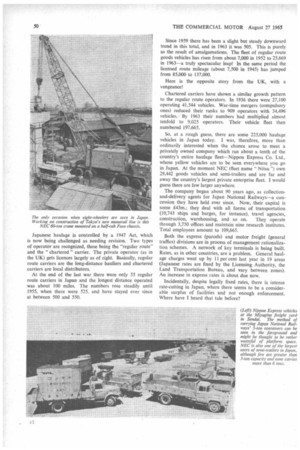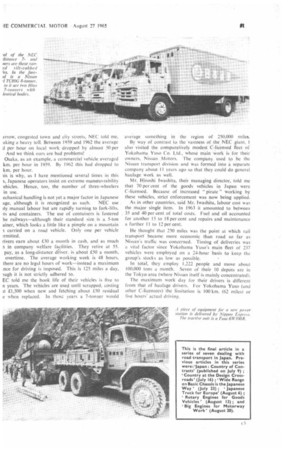JAPAN'S HAULAGE BOOM
Page 51

Page 52

Page 53

If you've noticed an error in this article please click here to report it so we can fix it.
82% of traffic goes by road
PART VII OF A SERIES 3N JAPAN
3Y ALAN HAVARD, m hist T JO less than 81.9 per cent of all goods traffic in Japan
goes by road. This was the position in 1963 (the St year for which statistics are available) and the entage undoubtedly will have risen since then. In that le year 10.7 per cent of the total tonnage was moved rail, and 7.4 per cent by coastal shipping.
-1 1955 the tonnage percentage between road and rail 67.8 to 24.6; in 1963 it was 81-9 to 10.7. This is one 'sure of the road transport revolution which is going in the country. Ton-mileage figures tell a similar story. 1955 the railways operated 52 per cent of the national .1 and road vehicles 9 per cent. By 1963 the proportion altered to 33.2 per cent by rail and 23.2 per cent by J. These figures reflect, in particular, the opening up -oad communications in the past decade.
.at'ner as in this country, Japanese road haulage had
its roots in the 1920s. By 1937 it was carrying 52 per cent of the total tonnage—but an infinitesimal proportion of the ton-mileage. Road conditions were extremely primitive and so trucks operated only over very short distances. In 1940, for instance, there were some 27,750 carriers, mainly owning one or two vehicles, with a radius limitation of less than 15 mites from base.
The post-war decade to 1955 saw the haulage industry consolidate itself, bolstered by the awakening industries of the country. Road conditions began to improve, the railways suffered reconstruction problems, and industrialists discovered the particular advantages of owning their own fleets.
From 1955 to the present, the growth of big groups and large individual fleets became apparent, alongside road's growing challenge to rail in long-distance work.
Japanese haulage is controlled by a 1947 Act, which is now being challenged as needing revision. Two types of operator are recognized, these being the "regular route" and the " chartered " carrier. The private operator (as in the UK) gets licences largely as of right. Basically, regular route carriers are the long-distance hauliers and chartered carriers are local distributors.
At the end of the last war there were only 55 regular route carriers in Japan and the longest distance operated was about 100 miles. The numbers rose steadily until 1955, when there were 525, and have stayed ever since at between 500 and 550. Since 1959 there has been a slight but steady downward trend in this total, and in 1963 it was 505. This is purely as the result of amalgamations. The fleet of regular route goods vehicles has risen from about 7,000 in 1952 to 25,669 in 1963—a truly spectacular leap! In the same period the licensed route mileage (about 7,500 in 1945) has jumped from 85,000 to 137,000.
Here is the opposite story from the UK, with a vengeance!
Chartered carriers have shown a similar growth pattern to the regular route operators. In 1936 there were 27,100 operating 41,544 vehicles. War-time mergers (compulsory ones) reduced their ranks to 909 operators with 34,496 vehicles.By 1963 their numbers had multiplied almost tenfold to 9,025 operators. Their vehicle fleet then numbered 197,665.
So, at a rough guess, there are some 225,000 haulage vehicles in Japan today. I was, therefore, more than ordinarily interested when the chance arose to meet a privately owned company which ran about a tenth of the country's entire haulage fleet—Nippon Express Co. Ltd., whose yellow vehicles are to be seen everywhere you go in Japan. At the moment NEC (fleet name " Nitsu ") own 29,442 goods vehicles and semi-trailers and are far and away the country's largest private enterprise fleet. I would guess there are few larger anywhere.
The company began about 90 years ago, as collectionand-delivery agents for Japan National Railways—a concession they have held ever since. Now, their capital is some f43m.; they deal with all forms of transportation (10,743 ships and barges, for instance), travel agencies, construction, warehousing, and so on. They operate through 3,750 offices and maintain nine research institutes. Total employees amount to 109,665.
Both the express (parcels) and motor freight (general traffics) divisions are in process of management rationalization schemes. A network of key terminals is being built. Rates, as in other countries, are a problem. General haulage charges went up by 11 per cent last year in 19 areas (Japanese rates are fixed by the Licensing Authority, the Land Transportation Bureau, and vary between zones). An increase in express rates is about due now.
Incidentally, despite legally fixed rates, there is intense rate-cutting in Japan, where there seems to be a considerable surplus of facilities and not enough enforcement. Where have I heard that tale before? Arrow, congested town and city streets, NEC told me, aking a heavy toll. Between 1959 and 1962 the average d per hour on local work dropped by almost 50 per And we think ours are bad problems! , Osaka, as an example, a commercial vehicle averaged km. per hour in 1959. By 1962 this had dropped to km. per hour.
is is why. as I have mentioned several times in this s, Japanese operators insist on extreme rnanceuvrability 'chides. Hence, too, the number of three-wheelers in use.
echanical handling is not yet a major factor in Japanese age, although it is recognized as such. NEC use ily manual labour but are rapidly turning to fork-lifts, :ts and containers. The use of containers is fostered he railways—although their standard size is a 5-ton ainer, which looks a little like a pimple on a mountain I carried on a road vehicle. Only one per vehicle
rivers earn about £30 a month in cash, and as much 1 in company welfare facilities. They retire at 55. pay, as a long-distance driver, is about £50 a month. overtime. The average working week is 48 hours, there are no legal hours of work—instead a maximum nee for driving is imposed. This is 125 miles a day, )ugh it is not strictly adhered to.
EC told me the book life of their vehicles is five to n years. The vehicles are used until scrapped, costing it £1,500 when new and fetching about £50 residual e when replaced. In thosc years a 7-tonner would average something in the region of 250,000 miles.
By way of contrast to the "vastness of the NEC giant, 1 also visited the comparatively modest C-licensed fleet of Yokohama Yuso Co. Ltd., whose main "work is for their owners, Nissan „Motors. The comPany. used to be the Nissan transport division and was formed into a separate company about I I years ago so that they could do general haulage work as well.
Mr. Hiroshi Iwashita, their managing director, told me that 70 per cent of the goods vehicles in Japan were C-licensed. Because of increased " pirate " working by these vehicles, strict enforcement was now being applied.
As in other countries, said Mr. Iwashita, labour cost was the major single item. In 1963 it amounted to between 35 and 40 per cent of total costs. Fuel and oil accounted for another 15 to 18 per cent and repairs and maintenance a further II to 12 per cent.
He thought that 250 miles was the point at which rail transport' became irtore economic than road so far as Nissan's traffic was concerned. Timing of deliveries was a vital factor since Yokohama Yuso's main fleet of 237 vehicles were employed on a 24-hour basis to keep the group's stocks as low as possible.
In total, they employ 1,222 people and move about 100,000 tons a month. Seven of their 10 depots arc in the Tokyo area (where Nissan itself is mainly concentrated).
The maximum work day for their drivers is different from that of haulage drivers. For Yokohama Yuso (and other C-licensees) the limitation is 100 km. (62 miles) or five hours' actual driving.












































































































